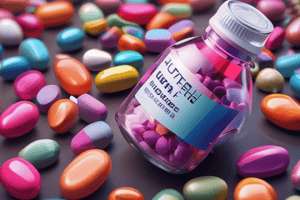Podcast
Questions and Answers
What is the primary mechanism by which drugs modify physiological functions?
What is the primary mechanism by which drugs modify physiological functions?
- Inhibition of cellular respiration
- Altering membrane permeability
- Interactions with cellular receptors (correct)
- Blocking neurotransmitter release
Which statement regarding Orlistat is true?
Which statement regarding Orlistat is true?
- It acts by stimulating insulin production.
- It binds to cellular receptors to exert its effect.
- It replaces lost molecules in diabetic patients.
- It inhibits the action of intestinal lipase. (correct)
In the context of diabetes mellitus, what role does insulin serve?
In the context of diabetes mellitus, what role does insulin serve?
- Direct stimulation of glucose production
- Inhibition of fatty acid synthesis
- Induction of cytotoxic effects on cells
- Replacement of a missing hormone (correct)
What type of effect do anticancer drugs primarily aim to achieve?
What type of effect do anticancer drugs primarily aim to achieve?
Which of the following best describes how most drugs act on target cells?
Which of the following best describes how most drugs act on target cells?
What is a common characteristic of drug interactions with ion channels?
What is a common characteristic of drug interactions with ion channels?
Which of the following is NOT a common mechanism by which drugs affect physiological functions?
Which of the following is NOT a common mechanism by which drugs affect physiological functions?
How does stimulation of physiological functions typically occur?
How does stimulation of physiological functions typically occur?
What characterizes a full agonist?
What characterizes a full agonist?
Which of the following statements is true about partial agonists?
Which of the following statements is true about partial agonists?
What distinguishes an antagonist from an agonist?
What distinguishes an antagonist from an agonist?
Which receptor type is located inside the cells?
Which receptor type is located inside the cells?
In terms of receptor response, how does a partial agonist compare to a full agonist?
In terms of receptor response, how does a partial agonist compare to a full agonist?
What is the role of affinity in pharmacology?
What is the role of affinity in pharmacology?
How would you describe the intrinsic activity of an antagonist?
How would you describe the intrinsic activity of an antagonist?
Which receptor class does a GPCR (G-protein-coupled receptor) belong to?
Which receptor class does a GPCR (G-protein-coupled receptor) belong to?
What triggers ligand-gated ion channels to open?
What triggers ligand-gated ion channels to open?
Which ions can potentially flow through ligand-gated ion channels upon activation?
Which ions can potentially flow through ligand-gated ion channels upon activation?
In enzyme-linked receptors, what happens upon binding of a peptide hormone?
In enzyme-linked receptors, what happens upon binding of a peptide hormone?
What role does tyrosine-kinase activity play in enzyme-linked receptors?
What role does tyrosine-kinase activity play in enzyme-linked receptors?
What is the definition of synergistic effects in pharmacology?
What is the definition of synergistic effects in pharmacology?
Which type of antagonist can be displaced by higher agonist concentrations?
Which type of antagonist can be displaced by higher agonist concentrations?
What is the primary function of G-protein coupled receptors (GPCR)?
What is the primary function of G-protein coupled receptors (GPCR)?
What is one consequence of ion influx through ligand-gated ion channels?
What is one consequence of ion influx through ligand-gated ion channels?
What is the expected outcome of the combination of drug A and drug B when they have an antagonistic effect?
What is the expected outcome of the combination of drug A and drug B when they have an antagonistic effect?
Which of the following hormones primarily utilizes enzyme-linked receptors?
Which of the following hormones primarily utilizes enzyme-linked receptors?
In the example of Orlistat and Drug X, what is the combined effect when used together?
In the example of Orlistat and Drug X, what is the combined effect when used together?
Which characteristic differentiates a competitive antagonist from a non-competitive antagonist?
Which characteristic differentiates a competitive antagonist from a non-competitive antagonist?
Which compartment do GPCRs primarily function in?
Which compartment do GPCRs primarily function in?
What does an additive effect of drug treatment indicate?
What does an additive effect of drug treatment indicate?
What happens with higher agonist concentrations regarding a non-competitive antagonist?
What happens with higher agonist concentrations regarding a non-competitive antagonist?
In pharmacology, what is expected from a synergetic effect when combining two drugs?
In pharmacology, what is expected from a synergetic effect when combining two drugs?
What is receptor desensitization?
What is receptor desensitization?
Which statement about the therapeutic index is incorrect?
Which statement about the therapeutic index is incorrect?
What can result from receptor desensitization?
What can result from receptor desensitization?
Which mechanism does NOT contribute to receptor desensitization?
Which mechanism does NOT contribute to receptor desensitization?
How is the therapeutic index for humans defined?
How is the therapeutic index for humans defined?
Which of the following is a potential clinical strategy to manage receptor desensitization?
Which of the following is a potential clinical strategy to manage receptor desensitization?
What does the dose-response curve illustrate?
What does the dose-response curve illustrate?
What is the meaning of the term 'drug holiday'?
What is the meaning of the term 'drug holiday'?
Flashcards are hidden until you start studying
Study Notes
Synergistic Effects
- Synergistic effects occur when the combined effect of two drugs is greater than the sum of their individual effects.
- Example: Drug A + Drug B > Drug A + Drug B
Antagonistic Effects
- Antagonistic effects occur when the combined effect of two drugs is less than the sum of their individual effects.
- Example: Drug A + Drug B < Drug A + Drug B
Receptor Actions
- Competitive Antagonist: A drug that binds to the same site as the agonist and blocks its action.
- Non-Competitive Antagonist: A drug that binds to a different site on the receptor than the agonist, causing a conformational change that prevents the agonist from binding.
Common Ways Drugs Alter Physiological Functions
- Stimulation: Increase the function of the target molecule or cell.
- Inhibition: Decrease the function of the target molecule or cell.
- Replacement: Provides a missing molecule or replaces one that is being produced in insufficient amounts.
- Cytotoxicity: Kills cells, used to treat cancer.
Drug Interactions with Target Cells
- Receptors: The most common mechanism for drug action. Drugs bind to receptors and trigger a cellular response.
- Enzymes: Drugs can inhibit or activate enzymes, altering their function.
- Ion Channels: Drugs can block or open ion channels, altering the flow of ions across cell membranes.
Agonists, Partial Agonists, and Antagonists
- Agonists: Drugs that bind to receptors and activate them, mimicking the effect of the natural ligand.
- Partial Agonists: Drugs that bind to receptors and activate them to a lesser extent than full agonists.
- Antagonists: Drugs that bind to receptors and block the action of agonists. They have affinity but no intrinsic activity.
Types of Receptors
- Cell Surface Receptors: Located on the cell membrane.
- Ligand-gated Ion Channels: These receptors open or close an ion channel in response to binding of a ligand.
- Enzyme-linked Receptors: These receptors activate an intracellular enzyme upon binding of a ligand.
- G-Protein Coupled Receptors (GPCRs): These receptors activate a G protein, which then triggers a signaling cascade.
- Intracellular Receptors: Located inside the cell, typically in the cytoplasm. These receptors often bind to steroid hormones.
Receptor Desensitization & Downregulation
- Desensitization: A process where the cell or tissue becomes less responsive to a drug over time. This can impact the effectiveness of the drug and might require drug holidays, higher doses, or combination therapy to maintain therapeutic efficacy.
Dose-Effect Curve
- Dose-Response Curve: Plots the relationship between the dose of a drug and the magnitude of the effect.
- Therapeutic Index (TI): A measure of the safety of a drug. It is the ratio of the lethal dose (LD50) to the effective dose (ED50).
Therapeutic Index (TI)
-
In Animals: TI = LD50/ED50
-
In Humans: TI = TD50/ED50 (TD50 is the toxic dose)
-
There is no lethal dose (LD50) measured in humans.
-
Higher TI: More safe drug, as the margin between therapeutic and toxic doses is larger.
-
Lower TI: Less safe drug, as the margin between therapeutic and toxic doses is narrower.
Studying That Suits You
Use AI to generate personalized quizzes and flashcards to suit your learning preferences.




